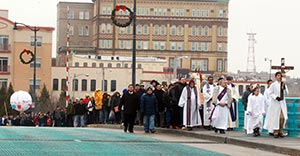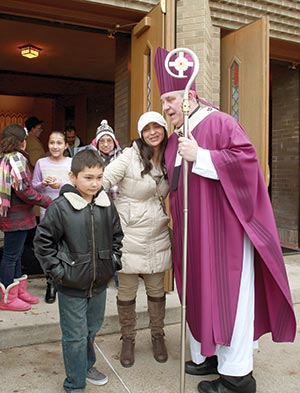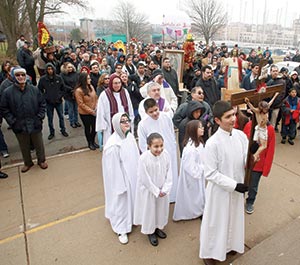About 400 people gathered at Cristo Rey Parish in Racine Sunday morning, Nov. 30, and processed a mile to the parish’s new home at St. Patrick. Altar server Francisco Gutierrez leads parishioners in a procession from Cristo Rey Catholic Church (seen in the background) across a bridge over the Root River on their journey to their new parish, St. Patrick, Racine, Sunday, Nov. 30. A closing Mass was celebrated at Cristo Rey on Nov. 23. Following the procession to St. Patrick, Archbishop Jerome E. Listecki celebrated a Mass for the newly united St. Patrick Parish. (Catholic Herald photo by Allen Fredrickson)
Altar server Francisco Gutierrez leads parishioners in a procession from Cristo Rey Catholic Church (seen in the background) across a bridge over the Root River on their journey to their new parish, St. Patrick, Racine, Sunday, Nov. 30. A closing Mass was celebrated at Cristo Rey on Nov. 23. Following the procession to St. Patrick, Archbishop Jerome E. Listecki celebrated a Mass for the newly united St. Patrick Parish. (Catholic Herald photo by Allen Fredrickson)
The procession was a homecoming of sorts.
Cristo Rey parish was formed about 35 years when a group of St. Patrick members wanted to start a Hispanic parish. The group began meeting in the building across the street from St. Patrick, until it acquired the former St. Mary Church building in 1983.
Back then, the people processed the opposite way down the street from St. Patrick to Cristo Rey.
Now, the two groups are reunited as one parish.
On Sunday, Archbishop Jerome E. Listecki celebrated the inaugural Mass for the new, combined St. Patrick Parish. Parish administrations have spent the past year preparing the congregations for the merger, but according to Fr. Antony Thomas, pastor, the union has little to do with the leaders.
“It is all about the people. They are the ones who actually led this procession, led the community, lent their hands for this thing,” Fr. Thomas said.
Investing in the future
The merger will enable the parishes to have stronger programs, he said.
“We are committed to our community outreach programs, with youth ministry, visiting the homebound, hospital ministry and human concerns. Hopefully we can expand those ministries.” said Eloy Contreras, youth minister for the united parish.
To be successful, special attention must be given to the youth, Fr. Thomas said. Maricela Gutierrez, and her 9-year-old son Abraham Gutierrez are greeted by Archbishop Jerome E. Listecki following Mass at their new parish last Sunday. (Catholic Herald photo by Allen Fredrickson)
Maricela Gutierrez, and her 9-year-old son Abraham Gutierrez are greeted by Archbishop Jerome E. Listecki following Mass at their new parish last Sunday. (Catholic Herald photo by Allen Fredrickson)
“Our youth are not getting so much from the church. When I ask most of them, they will say it’s boring, they don’t get anything from the church. I think that is why I am concentrating so much on the youth ministry, because I think they are the future of the church,” Fr. Thomas said.
He continued, “If we don’t motivate the youth, we won’t be having religious nuns or priests or anything. For me that is the most important thing. When they get older, if they are rooted in faith, they will continue.”
Until the last several years, Cristo Rey did not have a youth minister on staff, due to lack of funds. Many of the students began going to a local Lutheran church, Contreras said.
“They seem to really stimulate the young people, and they invest in their youth,” he said.
So, over the last several years, the two parishes have made an effort to strengthen their youth ministry program, and the youth have returned, Contreras said. The joint youth ministry program has offered prayer, service and recreational opportunities for students.
In addition, because the parish is predominantly Hispanic, immigration is a major issue for many of the parishioners. Parishioners hope the parish will now have better resources to meet those needs, he said.
Cristo Rey formed in 1970s
The roots of Cristo Rey parish date to the 1970s, when a group of Hispanics formed within St. Patrick Parish.
“At that time, there were some sort of racially sensitive issues where they felt like they weren’t really welcomed at the time, and so they kind of formed a group,” Contreras said. “They felt like they weren’t getting their needs met there, at a predominantly Anglo community.”
“They wanted to develop their own leadership. There was a real strong sense of having a parish that had a clear Hispanic, Latino identity,” said Don Mueller, a St. Patrick parishioner.
 After processing about a mile through the streets of Racine, members of Cristo Rey Catholic Church wait to enter their new parish, St. Patrick, Racine, Nov. 30. (Catholic Herald photo by Allen Fredrickson)However, not all of the Hispanic members left St. Patrick Parish, and over the next three decades, the Hispanic population continued to grow at St. Patrick. By last year, 70 percent of St. Patrick’s population was Hispanic, Contreras said, adding that the mission of the two churches had become similar.
After processing about a mile through the streets of Racine, members of Cristo Rey Catholic Church wait to enter their new parish, St. Patrick, Racine, Nov. 30. (Catholic Herald photo by Allen Fredrickson)However, not all of the Hispanic members left St. Patrick Parish, and over the next three decades, the Hispanic population continued to grow at St. Patrick. By last year, 70 percent of St. Patrick’s population was Hispanic, Contreras said, adding that the mission of the two churches had become similar.
Meanwhile, Cristo Rey was barely scraping by financially, he noted.
“We didn’t have enough money for a human concerns committee, we didn’t have youth ministry, we didn’t have any kind of outreach ministry. And so at some point, people were asking the question, ‘How can we do social justice if we are saying we are just barely paying the bills?’” Contreras said.
For Cristo Rey’s first 17 years, Capuchin priests served the community, and the parish did not pay a priest or any hired staff.
“We didn’t have to pay anything, but we also weren’t doing any kind of outreach ministry because the thing of it was we didn’t have any money. We had to ask: Are we just offering Masses and not any kind of community outreach or community building?” Contreras said.
The parish took a long, hard look at itself, he said.
“The big question was are we doing what Christ asks us to do with his people? The hard answer that we had to really come to terms with was no, we weren’t. We were just a building where we just prayed on Sundays, but we weren’t doing anything else,” Contreras said.
Parish struggled financially
Over the past three decades, St. Patrick also has struggled financially, Mueller said.
Last November, the parish councils from the two parishes came together and discussed whether they could provide more if they pooled their resources, Fr. Thomas said.
In March, Bishop Donald J. Hying announced that the two parishes would merge.
“It was time to bring back the ministry of Cristo Rey back to where it originated, which was in the heart of St. Patrick,” Contreras said.
Moving forward
St. Patrick, known as the Mother Church in Racine, is a welcoming parish, he said.
“At St. Patrick, if they notice somebody out of place, you will be swarmed with smiles and how are you. You would be welcomed,” Contreras said.
The Sunday morning English Mass has an especially tremendous sense of community, Mueller said.
“The sense of church as community was always accentuated in that parish,” he said.
“There is something special about St. Patrick,” said Rita Griffiths, who joined the parish seven years ago. “It is a family, and it is a wonderful place. I don’t think I would care how small the Anglo population was, as long as it remained what it is, which is a family. And so we welcome the people from Cristo Rey as family.”
Still, it is not easy for people to leave Cristo Rey.
“There are a lot of people that are upset about combining the parishes because this has been their home for 35 years,” Fr. Thomas acknowledged.
Bishop Don Hying presided at the closing Mass on Sunday, Nov. 23, at Cristo Rey.
“At the closing Mass, it seemed bittersweet. There were a lot of tears,” Contreras said. “I baptized my children there, I was married there, and we buried a son there. And so there is a lot of connection there.”
Still, he is OK with the building closing.
“It is the community of Cristo Rey that lives on,” Contreras said.
To help the people feel more at home, the marble altar was moved from Cristo Rey to St. Patrick. The McCarthy Hall was renamed Cristo Rey Parish Hall. The educational building is now called the Cristo Rey Educational Complex.
The Christ the King (Cristo Rey) statue was brought over and placed in a prominent place in St. Patrick. Cristo Rey’s painting of Our Lady of Guadalupe was transferred to the new location.
“All of those things were brought over to the new parish, so we felt that there is something we were bringing over to the newly formed St. Patrick community,” Contreras said.
The parishes have been doing other things to help the merger go smoothly. For more than four years, Fr. Thomas has been the pastor of both parishes.
The various committees have been meeting jointly since the summer. A group called “God’s Love Unites Us” has been meeting to understand and address issues involved with the merger. And there has been a lot of prayer, Griffiths added.
The work seems to have paid off. Many people have told Fr. Thomas, “Father, we have a home.”
There are about 1,500 families registered at the united St. Patrick Parish, but Fr. Thomas said he thinks the parish is actually larger than that. About 85 percent of the community is Hispanic and 15 percent is Anglo, he said.
The church has a seating capacity of 520 people; there are four Masses on Sundays and one on Saturdays.
Cristo Rey parishioner Isidro Gutierrez is glad his parish has a new home.
“It is kind of exciting. We have this church; they didn’t drop us and close the door, and say the church is closed, and I have to find another place,” Gutierrez said. “It is too bad that we have to close Cristo Rey, but it’s for a good thing. We are going to build our community stronger.”
However, people must work and be active in order to make the parish viable, Gutierrez said.
“We are the church. That is what people have to understand. It is not about the building. It is about the people. No matter where we got together, God is going to be right there. I will miss my church. But it is just a building,” Gutierrez said.
“This is not about being Hispanic or race, this is about the people, the family of St. Patrick, and we are looking forward,” Gutierrez said.
